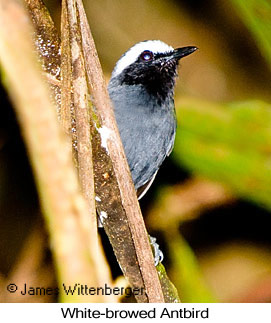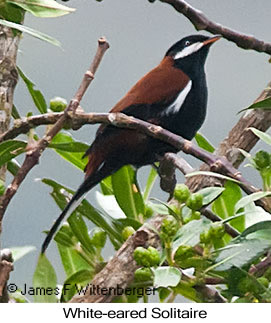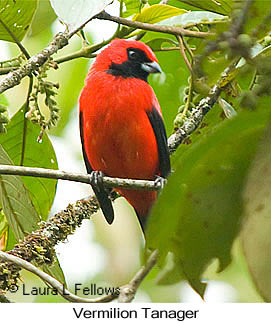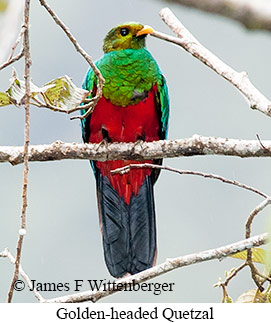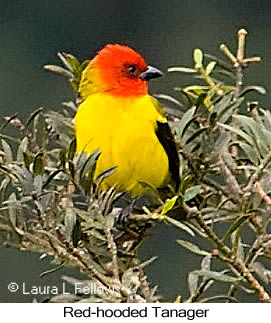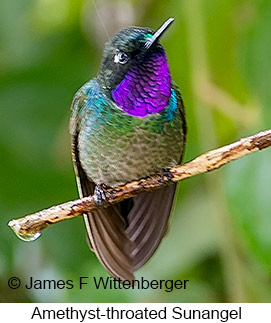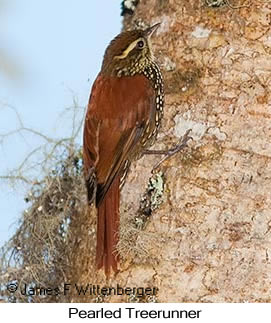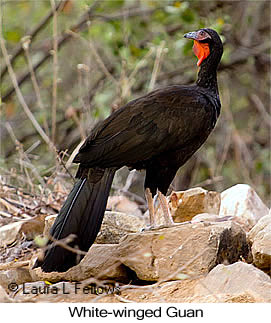NORTHERN PERU EXTENDED BIRDING TOUR
Tour Description

PERU
BIRDING TOUR
ANY TIME*
| Duration: | 23 days, 22 nights |
| Group Size: | 2-6 |
| Anytime Price: | $9350 |
| Group Price: | $8950 |
| Single Suppl: | $800 |
| Est #Species: | 700-775 |
| Pace: | Moderate |
| Difficulty: | Moderate |
| * This tour is available for any dates of your choosing provided guide services and accommodations are available. | |
DAY 1 - LIMA
Arrive at international airport in Lima and transfer to your hotel near the airport. Night at Wasi Airport Hotel.
DAY 2 - CHICLAYO & CHAPARRI
Morning flight to Chiclayo followed by transfer to Chaparri Reserve near Piura with some birding en route, arriving mid-day. Chaparri is a private reserve in the Tumbes Endemic Area of northeastern Peru. Habitat is dry scrub and semi-deciduous forest. Some 39 species restricted to arid northwestern Peru and southeastern Ecuador, "Tumbesian endemics", are found in the reserve. A few are rare or only seasonally present, but most are resident and many are common or fairly common.
The reserve was established to protect the endangered White-winged Guan, easily seen there, and Spectacled Bear, also commonly seen. In slightly higher humid forest, the rare and quite shy Ochre-bellied Dove occurs. and there is a good chance of seeing this species as well. A variety of other specialties found only in northwestern Peru and southwestern Ecuador are present in the reserve, including Gray-chinned Hermit, Guayaquil Woodpecker, Chapman's Antshrike, Rufous-necked Foliage-gleaner, Henna-hooded Foliage-gleaner, Gray-breasted Flycatcher, Tumbes Pewee, Baird's Flycatcher, Plumbeous-backed Thrush, Black-capped Sparrow, and more.
The area around the lodge features gardens and a pond that attract a variety of additional specialties such as Collared Antshrike, Elegant Crescentchest, Necklaced Spinetail, Tumbes Tyrannulet, Maranon Tyrannulet, Gray-and-white Tyrannulet, White-tailed Jay, White-headed Brushfinch, and White-edged Oriole. A variety of hummingbirds and other birds come to the feeders near the lodge, including Oasis Hummingbird, Short-tailed Woodstar, and Tumbes Hummingbird. In early evening some owling could produce Peruvian Screech-Owl, Peruvian Pygmy-Owl, and Striped Owl. Night at Chaparri Ecolodge.
DAY 3 - CHAPARRI RESERVE
This morning will be spent birding higher elevation cloud forest along the Casupe-Tocmoche Road, about an hour's drive from Chaparri. This is a relatively unexplored birding site offering chances to see birds such as Ecuadorian Trogon, Ecuadorian Piculet, Guayaquil Woodpecker, Rufous-necked Foliage-gleaner, Henna-hooded Foliage-gleaner, Piura Chat-Tyrant, Plumbeous-backed Thrush, Gray-and-gold Warbler, Black-cowled Saltator, and Black-capped Sparrow. Afternoon birding in the reserve. Night at Chaparri Ecolodge.
DAY 4 - BOSQUE DE POMAC & HIGHLANDS
Morning we'll transfer to Bosque de Pomac Historic Sanctuary, located northeast of Chiclayo. Aside from the interesting ruins, the dry forest and scrub habitat is excellent for a number of good birds. The primary target species are the endemic Peruvian Plantcutter, which can usually be found in dry scrub along the road, and Rufous Flycatcher. Of special interest is the very rare Tumbes Swallow, often seen flying above the Acacia forest in the reserve. Other interesting species here include Ecuadorian Piculet, Tumbes Chat-Tyrant, Short-tailed Field Tyrant, Snowy-throated Kingbird, and Tumbes Sparrow. In the afternoon we'll visit a remote canyon in the hills above Olmos. The habitat in this area is dry deciduous forest and harbors one of the best populations of White-winged Guan. A variety of more widely distributed species are also present in this area. Night at a hotel in Olmos.
DAY 5 - ABRA PORCULLA & JAEN
Morning transfer to Jaen with birding stop at Abra Porculla near Limon, gateway to the northern Peruvian Andes. Key species in arid shrubbery in the gullies are Peruvian Sheartail, Piura Chat-Tyrant, Bay-crowned Brushfinch, and Black-cowled Saltator. Site offers a last chance to find other specialties that may have been missed at Chaparri as well. We will arrive in Jaen mid-day in time for lunch.
Later in the afternoon we'll bird a small reserve on the outskirts of town looking for Marañon specialties such as Marañon Slaty-Antshrike, Marañon Crescentchest, Marañon Spinetail, and Little Inca Finch. Other possibilities are Chiguanco Thrush, Buff-bellied Tanager, and Black-capped Sparrow. Also of interest is the localized "Shumba" subspecies of Collared Antshrike, and the "Marañon" subspecies of Tropical Gnatcatcher, both possible future splits. Some early evening birding could yield Scrub Nightjar if not already seen at Chaparri. Night at a hotel in Jaen.
DAY 6 - JAEN & ABRA PATRICIA
We'll depart very early to look for West Peruvian Screech Owl, a possible future split. After dawn we'll explore dry forest looking for Marañon Spinetail if not seen earlier, Chinchipe Spinetail and local forms of Rufous-fronted Thornbird, Northern Slaty-Antshrike, and Black-capped Sparrow, all possible future splits. Also present are Scarlet-fronted Parakeet, a possible future split as Cordilleran Parakeet, Yellow-cheeked Becard, Buff-bellied Tanager, and other more widely distributed species. A stop at some paddy fields outside Jaen may offer views of Spotted Rail and other open country birds.
After lunch we'll depart for Abra Patricia with birding en route along the scenic Utcubamba River. The main bird of interest we hope to see en route is the endemic Marañon Thrush.In addition to fantastic scenery, Abra Patricia is home to the elusive and near mythical Long-whiskered Owlet. For many years this bird was rarely seen, but local knowledge has greatly improved our chances of seeing it. To improve our chances, we're spending 3 nights at Abra Patricia. Night birding to look for the Long-whiskered Owlet. Night at Owlet Lodge.
DAYS 7-8 - ABRA PATRICIA
We'll have two full days birding trails around Abra Patricia and nearby areas including Garcia Bridge. An extensive trail network through cloud forest and roadside birding offer numerous specialties. There's an excellent chance of seeing endemics such as Rufous-vented Tapaculo, Johnson's Tody-Flycatcher, Golden-browed Chat-Tyrant, White-eared Solitaire, and Yellow-scarfed Tanager. Another specialty lurking in dense vegetation is the very cute Johannes's Tody-Tyrant. Other possibilities include Uniform Antshrike, Streak-headed Antbird, the endemic Rufous-vented Tapaculo, Spotted Barbtail, Rufous Spinetail, Rufous-headed Pygmy-Tyrant, Black-throated Tody-Tyrant, the endemic Peruvian Tyrannulet, Sharpe's Wren, Chestnut-capped Brushfinch, and Red-hooded Tanager.
A variety of specialties known mainly from inaccessible sites in southern Ecuador are readily accessible by road at Abra Patricia. These include Royal Sunangel, Cinnamon-breasted Tody-Tyrant, and Bar-winged Wood-Wren. Roadside birding also offers the possibility of mixed flocks comprised of species such as Common Chlorospingus, Rufous-crested Tanager, Oleaginous Hemispingus, Vermilion Tanager, a key target species, Lacrimose Mountain Tanager, Blue-winged Mountain Tanager, Yellow-throated Tanager, Beryl-spangled Tanager, and Metallic-green Tanager, the scarce Blue-browed Tanager, another target species Saffron-crowned Tanager, Flame-faced Tanager, Capped Conebill, Masked Flowerpiercer, and Gray-hooded Bush Tanager.
We may spend one morning birding the drier forests downslope near Affluente, which features upper tropical forest. This is good habitat for Andean Cock-of-the-Rock. Many other new species are possible including Ecuadorian Piedtail, Versicolored Barbet, Little Woodpecker, Golden-olive Woodpecker, Rufous-rumped Antwren, White-crowned Tapaculo, Streaked Xenops, Montane Foliage-gleaner, Buff-fronted Foliage-gleaner, Black-billed Treehunter, Equatorial Graytail, Ash-browed Spinetail, Golden-winged Manakin, Scarlet-breasted Fruiteater, Scaled Fruiteater, Slaty-capped Flycatcher, Ecuadorian Tyrannulet, Spotted Tody-Flycatcher, Ornate Flycatcher, Olivaceous Greenlet, Gray-mantled Wren, Chestnut-breasted Wren, Orange-bellied Euphonia, Yellow-throated Chlorospingus, Ashy-throated Chlorospingus, White-winged Tanager, Orange-eared Tanager, Spotted Tanager, Blue-necked Tanager, Paradise Tanager, Bay-headed Tanager, Green-and-gold Tanager, Golden Tanager, and Deep-blue Flowerpiercer.
Antpittas are a special attraction at Abra Patricia. In recent years the localized endemic Ochre-fronted Antpitta, normally very difficult to see, has been coming to feeders. Also coming to feeders are the endemic Rusty-tinged Antpitta, Chestnut Antpitta, and the recently split Leymebamba Antpitta.
Interesting hummingbirds attracted to lodge feeders include Green-fronted Lancebill, Amethyst-throated Sunangel, Greenish Pufflet, Emerald-bellied Puffleg, Mountain Velvetbreast, Sword-billed Hummingbird, and Chestnut-breasted Coronet. Nights at Owlet Lodge.
DAY 9 - HUEMBO CENTER, & FUNDO ALTO NIEVA
We'll depart before dawn for the San Lorenzo Trail. The trail winds uphill through cultivated lands to eventually reach some very fragmented patches of forest. During our hike up we may hear and hope to see a White-throated Screech-Owl before dawn. The main target bird at out destination is the elusive Pale-billed Antpitta, an endemic rarely seen on birding tours. Also present is the "gray-browed" subspecies of Plain-tailed Wren, a probable future split, along with the endemic Russet-mantled Softtail and Unstreaked Tit-Tyrant. Other possibilities include Amethyst-throated Sunangel, Violet-throated Starfrontlet, Buff-browed Foliage-gleaner, Black-capped Tyrannulet, Brown-backed Chat Tyrant, Rufous-breasted Chat-Tyrant, Smoky Bush-tyrant, Yellow-breasted Brushfinch, Grass-green Tanager, and Blue-backed Conebill.
After lunch we may visit nearby Huembo Center if the Marvelous Spatuletail, perhaps the world's most spectacular hummingbird, has been coming to feeders there. Other interesting hummingbirds typically present are Chestnut-breasted Coronet, Velvet-fronted Brilliant, Purple-throated Sunangel, Emerald-bellied Puffleg, sometimes Little Woodstar, and White-bellied Hummingbird. The grounds offer some good birding in addition to the feeders. Birds of interest we may see include Peruvian Pigeon, Speckle-chested Piculet, Speckle-breasted Wren, Bar-winged Wood-Wren, Green-throated Tanager, and Chestnut-breasted Chlorophonia. Later, we'll visit nearby Pomacochas Lagoon to look for Plumbeous Rail and Subtropical Dorito. From there we'll transfer to Fundo Alto Nieva.
Fundo Alto Nieva is the most reliable site for seeing the Long-whiskered Owlet. Thanks to research by local rangers, a few territories are now identified where this prized species is regularly seen. Time permitting, we'll bird trails through the white-sand forest in the reserve, which offer possibilities such as Speckle-chested Piculet, Rusty-tinged Antpitta, Ochre-fronted Antpitta, Cinnamon-breasted Tody-Tyrant, Johnson's Tody-Flycatcher, White-capped Tanager, and the rare Yellow-scarfed Tanager. Hummingbird feeders offer the best place in Peru to see the prized Royal Sunangel and the rare Rufous-vented Whitetip. Night at Fundo Alto Nieva.
DAY 10 - AGUAS VERDES & WAQANKI RESERVE
We'll depart early for a private nature reserve near Aguas Verdes. A blind near some feeders offers views of usually difficult species such as Cinereous Tinamou, Little Tinamou, Rufous-breasted Wood-Quail, and Orange-billed Sparrow. Nearby hummingbird feeders attract Blue-fronted Lancebill, Many-spotted Hummingbird, occasionally Little Woodstar, Sapphire-spangled Emerald, Reddish Hermit, and Gray-breasted Sabrewing. Nearby forests feature Peruvian Warbling-Antbird, Zimmer's Antbird, Yellow-margined Flycatcher, Short-crested Flycatcher, Orange-backed Troupial, Black-bellied Tanager, Golden-eared Tanager, and Guira Tanager. Afternoon transfer to Moyobamba with birding stops en route as time permits to look for Pale-eyed Blackbird and Black-billed Seed-Finch. Night at Waqanki Lodge.
DAY 11 - WAQANKI RESERVE & MOYABAMBA
We'll spend the morning birding trails around Waqanki Reserve, also known as Quebrada Mishquiyacu. Key target species in this forest reserve are the recently described Painted Manakin as well as the "San Martin" form of Mishana Tyrannulet, a likely future split. Other specials include Band-bellied Owl, Spot-tailed Nightjar, Fiery-capped Manakin, Black-and-white Tody-Flycatcher, Buff-tailed Sicklebill, Fiery-throated Fruiteater, Varzea Thrush, and Red-shouldered Tanager. Numerous other upper tropical zone species are also present, including Blue-crowned Trogon, Lafresnaye's Piculet, Tschudi's Woodcreeper, Plain-winged Antshrike, Stripe-chested Antwren, Foothill Antwren, White-browed Antbird, Spot-winged Antbird, Wing-barred Piprites, Short-tailed Pygmy-Tyrant, Forest Elaenia, Ochre-bellied Flycatcher, Yellow-browed Tody-Flycatcher, Olive-faced Flatbill, Coraya Wren, Fulvous-crested Tanager, Turquoise Tanager, Masked Tanager, Yellow-bellied Tanager, and Buff-throated Saltator. Hummingbird feeders attract Black-throated Hermit, Great-billed Hermit, Rufous-crested Coquette, Black-throated Mango, Violet-headed Hummingbird, Blue-tailed Emerald, White-chinned Sapphire, Golden-tailed Sapphire, and Fork-tailed Woodnymph. Lowland sites near Moyabamba can be good for Masked Duck, Russet-crowned Crake, Stygian Owl, Rufous Nightjar, Bluish-fronted Jacamar, Amazonian jTrogon, Amazonian Motmot, Sulphury Flycatcher, Rusty-backed Antwren, Stripe-necked Tody-Tyrant, Red-capped Cardinal, Black-faced Tanager, and White-browed Purpletuft. Night at Waqanki Lodge.
DAY 12 - WAQANKI RESERVE & TRANSFER
After some morning birding at Waqanki Lodge, we'll depart for Tarapoto and then continue on to the village of Bellavista to the south. En route to Tarapoto a deep roadside canyon offers an excellent opportunity to view Oilbirds, one of the easiest places in the world to see them. South of Tarapoto we'll look for Sand-colored Nighthawk along the Huallaga River. Night at a hotel in the village of Bellavista.
DAY 13 - TRANSFER & PLATAFORMA
Early this morning we'll drive a rough road to Plataforma, the most accessible site in the world to see the highly localized endemic Scarlet-banded Barbet. The transfer may take some time depending on road conditions. Lately, conditions have been much improved. Rest of the day birding Plataforma area. Trails can be very muddy so rubber boots are advisable. The barbet is reliably seen at Plataforma but is not especially easy to find. Also present is the recently discovered Plataforma Antbird, a second target species there. Other good species likely to be seen include Rose-fronted Parakeet, Chestnut-tipped Toucanet, Wire-crested Thorntail, Rufous-breasted Antthrush, Short-tailed Antthrush, Rufous-rumped Foliage-gleaner, Gray-tailed Piha, Yungas Manakin, Foothill Schiffornis, Amazonian Umbrellabird, and Blue-browed Tanager. Early evening birding could well produce views of Foothill Screech-Owl near the lodge. Night at nearby La Flor Cafe.
DAY 14 - PLATAFORMA & TARAPOTO
Morning birding the forest reserve, another chance at both target species before returning to Tarapoto in the afternoon. Night at a hotel in Tarapoto.
DAY 15 - CORDILLERA ESCALERA, ACONABIKH CENTER, & LIMA
The Cordillera Escalera north of Tarapoto, also known as the Tarapoto Tunnel area, is an important lowland birding site north of Tarapoto featuring a mix of lowland and foothill species. Birding on either side of the 100m long tunnel is mainly along the road in remnant forest patches. The most desired target species is the seldom seen Dotted Tanager. Other interesting species include Koepcke's Hermit at feeders at Aconabikh Centre, the near endemic Rose-fronted Parakeet, and others such as Ocellated Woodcreeper, Fiery-throated Fruiteater, and Oriole Blackbird. Around mid-day we'll visit Aconabikh Center to view hummingbirds at the feeders. The main target species is Koepcke's Hermit, normally very difficult to find but lately coming to feeders there. Also present are Gould's Jewelfront and with some luck the scarce Black-throated Brilliant. There are also forest trails at Aconabikh Center where Golden-headed Manakins display on a lek. If we encounter an army ant swarm, we have a good chance of seeing White-plumed Antbird and maybe even the seldom seen Hairy-crested Antbird. From there we'll return to Tarapoto for an overnight stay there. Night at a hotel in Tarapoto.
DAY 16 - TRANSFER TO LEIMEBAMBA
After breakfast depart for Leimebamba, a long 8+ hour but scenic drive through the Utucamba River canyon into the mountains. En route we'll stop to look for the endemic Koepcke's Screech-Owl, which can often be seen along the road. Night at a hotel in Leimebamba.
DAY 17 - HIGHLANDS & LEIMEBAMBA
Morning will be spent in the highlands above Leimebamba, leaving our hotel before dawn to search for Swallow-tailed Nightjar before first light. At higher elevation the Elfin forest is home to our main target species, the poorly known Russet-mantled Softail. Other target species, both difficult skulkers, are Utcubamba Tapaculo and Chachapoya Antpitta. Other interesting species include the endemic Coppery-naped Puffleg and more widely distributed species such as Crimson-mantled Woodpecker, White-chinned Thistletail, Barred Fruiteater, Streak-throated Bush-Tyrant, Scarlet-bellied Mountain Tanager, and Buff-breasted Mountain Tanager. At still higher elevationis Elfin woodland and open paramo along Abra Barro Negro ("Black Mud Pass"). Here we may find Rainbow Starfrontlet, Many-striped Canastero, White-throated Tyrannulet, and other higher elevation species.
Later that afternoon we'll spend some time back in Leimebamba. Hummingbird feeders and gardens at the Leimebamba Museum attract Amethyst-throated Sunangel, Purple-throated Sunangel, Green-tailed Trainbearer, Rainbow Starfrontlet, Sword-billed Hummingbird, White-bellied Woodstar, White-bellied Hummingbird, and sometimes the spectacular Marvelous Spatuletail. There is also excellent birding in a valley outside town where it's possible to find Black-tailed Trainbearer, Gray-breasted Mountain-Toucan, Rufous-capped Antshrike, Highland Elaenia, Rufous-chested Tanager, and Black-throated Flowerpiercer. Nights at a hotel in Leimebamba.
DAY 18 - BALSAS
We'll depart very early to descend the mountains to the town of Balsas, arriving by dawn to look for the endemic Yellow-faced Parrot in the deciduous woodlands outside town. We'll also look for the endemic Peruvian Pigeon in this same area. From there we'll drive up the western slope of the Marañon Canyon toward Celendin. We'll spend the afternoon birding at Hacienda Limon on the way to Celendin. En route we hope to see Yellow-faced Parrotlet, Black-necked Woodpecker, and Buff-bridled Inca Finch among the cacti of this dry landscape. At Hacienda Limon we will be looking for two new endemics, Chestnut-backed Thornbird and the scarce Gray-winged Inca Finch. From the Hacienda we will continue upslope into a more humid region, arriving in Celendin by early evening. On the way we'll look for the local subspecies of Yellow-breasted Brushfinch, a possible future split as "Baron's Brushfinch". Night at a hotel in Celendin.
DAY 19 - CRUZ CONGA
This morning will be devoted to looking for the recently split endemic the lovely colonial city of Cajamarca Antpitta. The likely locale for this species is the highlands southeast of Celendin at Cruz Conga. Also present there is the very localized White-tailed Shrike-Tyrant. Other possibilities in this area are Shining Sunbeam, Striated Earthcreeper, Black-crested Tit-Tyrant, Rufous-webbed Bush-Tyrant, Jelski's Chat-Tyrant, Shining Sunbird, and other birds typical of this altitude. From there we'll continue on to Cajamarca. En route we'll stop to search for the endemic Gray-bellied Comet at a known site between Los Baños and Cajamarca. We'll eventually arrive in Cajamarca for an overnight stay. Hotel in Cajamarca.
DAY 20
We'll depart early for a drive south toward San Marcos to look for the rarely seen Great Spinetail. This highly localized endemic is found in a few valleys south of Cajamarca, the nearest about an hour south of the city. While in the area we'll also look for the skulky endemic Unicolored Tapaculo. A variety of other species are found in the same area including Striped Cuckoo, Tyrian Metaltail, Purple-collared Woodstar, Golden-rumped Euphonia, Black-lored Yellowthroat. We'll then continue southwest to the town of Huamachuco. If the spinetail was missed at San Marcos, this transfer is a second chance for this rare species. Night at a hotel in Huamachuco.
DAY 21 - EL MOLINO
Early departure for El Molino in the upper Marañon watershed to search for the very range restricted Purple-backed Sunbeam in flowering Eucalyptus trees. Rest of day birding there. Other target species are the difficult White-cheeked Cotinga and the endemic Rufous-eared Brushfinch. Additional birds of interest include Green-tailed Trainbearer, Rainbow Starfrontlet, Great Sapphirewing, White-banded Tyrannulet, White-throated Tyrannulet, Chiguanco Thrush, and Blue-and-yellow Tanager. Some afternoon birding the Puna region may turn up Andean Condor along with possibly Slender-billed Miner, Many-striped Canastero, Streak-throated Canastero, Rufous-webbed Bush-Tyrant, Black-billed Shrike-Tyrant, and Black-throated Flowerpiercer. Night at a hotel in Huamachuco.
DAY 22 - SINSICAP & TRUJILLO
Depart early for the coastal area and Trujillo. We'll spend the morning birding around Sinsicap high in the Andes Mountains above town. The main target bird there is the endemic Russet-bellied Spinetail. Other birds there include Speckled Hummingbird, Bronze-tailed Comet, Pied-crested Tit-Tyrant, Yellow-billed Tit-Tyrant, Tumbes Pewee, Piura Chat-Tyrant, and Bay-crowned Brushfinch. Also possible are Black-necked Woodpecker, Pacific Parrotlet, Unicolored Tapaculo, and Golden Grosbeak. From there we continue to Trujillo for a relaxing lunch and some afternoon birding where we can expect various widely distributed coastal species. We'll then return to Lima on an early evening flight. Tour ends at the airport in Lima. Overnight stay in Lima or overnight flight home.
DAY 23 - ARRIVAL
Arrive home from overnight flight.
ADDITIONAL INFO
(Not on Menu Above)
BIRDING LOCALES
